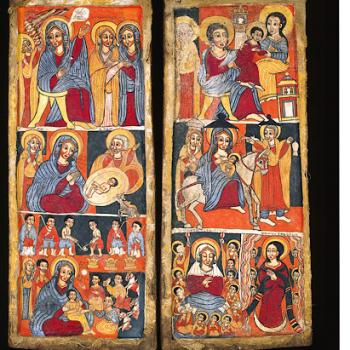And so it goes.
If a person or idea dies in Slaughterhouse Five, the Ecclesiastes of novels, Kurt Vonnegut includes this phrase.
And it is perfect for the experience of Dresden. I read the novel as I walked the town and lived in both the glorious past, the horrible past, the redeemed present, and the mysterious future.
Dresden is a city where time does not flow left to right in an orderly manner, but like Vonnegut’s book jumps about with no seeming pattern. This is false, just as false as thinking Vonnegut’s book is “anti-war.” It is anti-war, of course, but also anti-peace, if peace is the return to consumption and normalcy. Who is, after all, for bombings or for “normalcy?” Both war and tedium are equally able to kill the body.
And yet Vonnegut’s characters experiences unexpected goodness in time and access it the way a lover accesses golden memories. They are sacramental, outside of time’s normal stream, so can be accessed at any moment.
Dresden is in the same dialectic with time: it poses the question in frequent black and white pictures of rubble and answers it with gardens and rebuilt buildings. And yet ugly commercial building skip us ahead to a time when even old men will not be old enough to recall World War II and the only values will be those of the glib, the rich, and the botoxed.
I could walk down a street and see the horrible future, the horrible past, all in dialog with the present on the streets of Dresden. The city is a Vonnegut novel living around intense moments of reality that became central and accessible now matter when they happened.
And yet for me there was more in Dresden than Vonnegut saw, because Raphael’s Sistine Madonna was, is, and will be there. When I saw it, I left time, but not to Dresden, past, present, or future, but to the City of God. There stands a woman saying “yes” to God and so holding God in her arms: a God to whom her obedience gave life. Around her was ghostly cloud of witnesses and cherubs: one thoughtful, one impish.
Dresden wisely understand the centrality of this image of Mary. Ages past venerated the artist and the work and sold treasures of great price to bring it to the city. A throne was shoved out of the way to give space for Her display. But then wicked men commercialized the image and so tried to ruin it for us. The museum shows pieces of “art” that made Kinkaide-ist what Raphael saw. The cherubs in particular were used on celebrations of war, socialism, and normalcy.
They were reduced to cute.
And so it goes.
But the Raphael madonna defies this historic moment. The world changed and outside of Hallmark the marketers mercifully moved on to pillage other great art and music. The Mother of God waited and now I think has outlived those who loved her too unwisely to love her well.
Like the real Dresden, the Sistine Madonna is eternal.
I cannot own the picture, even the most careful reproduction risks bombing my memory. I can recall her just now, the Woman, standing saying “yes” to all that is life and denying no thing.
I can access that divine moment when I feel dark and Mary does not pretend the darkness is light, a sword pierced her heart and now sorrow pulverizes my own. She is always there, the spindle of the cosmos, unbombable, unkitschable, touchable.
And so it is, was, and ever shall be.











